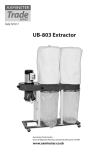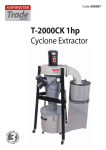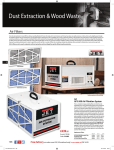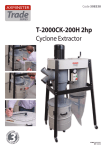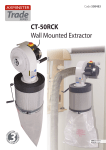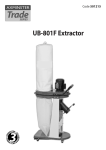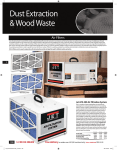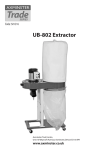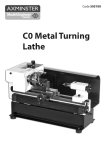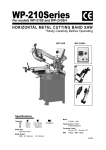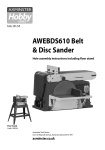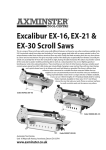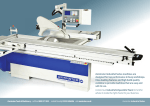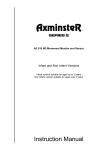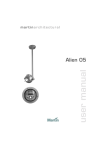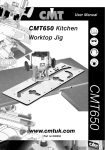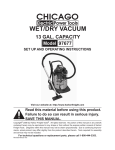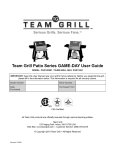Download User Manual - Axminster Power Tool Centre
Transcript
Code 210642 UB-2200VECK Cyclone Extractor AT&M: 28/5/2015 Index of Contents Index of Contents 02 Declaration of Conformity 03 What’s Included 03-04-05-06 General Instructions for 230V Machines 07 Specific Safety for Dust Extractors 07-08 Specification08 Assembly Instructions 08-09-10-11-12-13-14 Parts Description and Illustration 14-15 Operating and Adjustments 16 Maintenance17 Weekly LEV System Maintenance Log 18-19 LEV Testing 20 Parts Breakdown 21 Parts List 22-23-24 Wiring Diagram 25 Notes26-27 Declaration of Conformity Copied from CE Certificate manufactured by Chang Tjer Machinery Co., Ltd. is in compliance with the standards determined in the following Machinery Directive. 2006/42/EC The undersigned, authorised by EN 60335-1:2002 + A11: 2004 + A1: 2004 + A12: 2006 + A13: 2008 Manufactured by Chang Tjer Machinery Co., Ltd. No. 195-12, Chung Cheng RD., Ta Ya Dist., Taichung, 42850, Taiwan, R.O.C Model Number: UB-2200ECK (Dust Collector) Warning Fully read manual and safety instructions before use Ear protection should be worn The symbols below advise that you follow the correct safety procedures when using this machine. Eye protection should be worn Dust mask should be worn 2 Two man assembly Keep hands away from moving parts and cutting area What’s Included Quantity Item 1 No Cyclone Extractor 1 No Instruction Manual Box 1 Model Number UB-2200ECK Box 2 Quantity Item Part 1 No 1 No 2 No 2 No 2 No 2 No 1 No 1 No 1 No 1 No 1 No 1 No 1 No 4 No 2 No 1 No 5mm Hex Key 10-12mm Spanner Castor Wheels Fixed Castor Wheels Large Steel Clips Small Hose Clips Dust Bag Small Drum Sealing Tape Extractor Handle Flexible Connector Filter Sealing Tape Dust Bag Securing Clip Dust Bag Bin Castor Wheels Bin Lever Clamps with four Hex Head Coach Bolts Manometer and Hose 1 2 3 4 5 6 7 8 9 10 11 12 13 14 Quantity Item Part 1 No 1 No 1 No 1 No 1 No 1 No 1 No 2 No 1 No 1 No Bin Cover Large Flexible Hose Dust Extraction Adaptor Rear Filter Cover Cyclone Extractor Base Bin Upper Inner Panel Side Panels Lower Inner Panel Motor Extraction Assembly Bag Containing 16 No Large Bolts 24 No Hex Head Coach Screws 2 No Phillips Head Button Screws 7 No Small Phillips Screw 15 16 17 18 19 20 21 22 23 24 25 26 A B C D Please read the Instruction Manual prior to using your new machine. As well as the operating procedures for your new machine, there are numerous hints and tips to help you to use the machine safely and to maintain its efficiency and prolong its life. There is also a detailed description of the parts of your Cyclone Extractor, which will enable you to become familiar with terminology we will use in this manual. Keep this Instruction Manual readily accessible for any others who may also be required to use the machine. 3 1 A 2 B C D 4 3 What’s Included 5 6 7 10 8 11 9 12 13 4 What’s Included 14 16 15 20 17 18 19 5 What’s Included 22 21 23 24 25 26 6 General Instruction for 230V Machines Good Working Practices/Safety or around a sharp edge. If the work you are carrying out is liable to generate flying grit, dust or chips, wear the appropriate safety clothing, goggles, gloves, masks etc. If the work operation appears to be excessively noisy, wear ear-defenders. If you wear your hair in a long style, wearing a cap, safety helmet, hairnet, even a sweatband, will minimise the possibility of your hair being caught up in the rotating parts of the machine, likewise, consideration should be given to the removal of rings and wristwatches if these are liable to be a ‘snag’ hazard. Consideration should also be given to non-slip footwear, etc. The following suggestions will enable you to observe good working practices, keep yourself and fellow workers safe and maintain your tools and equipment in good working order. WARNING!! KEEP TOOLS AND EQUIPMENT OUT OF THE REACH OF YOUNG CHILDREN Mains Powered Tools and Machines Primary Precautions These machines are supplied with a moulded 16 Amp plug and 3 core power cable. Before using the machine, inspect the cable and the plug to make sure that neither are damaged. If any damage is visible, have the damaged item inspected/repaired by a suitably qualified person. If it is necessary to replace the plug, it is preferable to use an ‘unbreakable’ type that will most resist damage. Only use a 16 Amp plug, and make sure the cable clamp is tightened securely. Fuse as required. If extension leads are to be used, carry out the same safety checks on them, and ensure that they are correctly rated to safely supply the current that is required for your machine. Remember, most machines or tools have handles or holding positions, the power cable is not one of them. Workplace/Environment Do not use this machine if you are tired, your attention is wandering or you are being subjected to distraction. Do not use this machine within the designated safety areas of flammable liquid stores or in areas where there may be volatile gases. There are very expensive, very specialised machines for working in these areas. Above all, OBSERVE…. make sure you know what is happening around you, and USE YOUR COMMON SENSE. Specific Safety for Dust Extractors Do not use this machine as a vacuum cleaner, try to keep the waste medium to wood by products. The machine is not designed for use outside. Keep the machine clean; it will enable you to more easily see any damage that may have occurred. Clean the machine with a damp soapy cloth if needs be, do not use any solvents or cleaners, as these may cause damage to any plastic parts or to the electrical components. It is good practice to leave the machine unplugged until work is about to commence, also make sure to unplug the machine when it is not in use, or unattended. To avoid inadvertent ‘start up’, if your machine is not fitted Do not uplift workshop floor debris (stones, nails, screws, paper etc., etc). Be aware that wood dust is an explosive medium. Do not allow any ‘naked light’ source to occur anywhere near the machine. This includes cigarettes, matches, etc, and do not place the machine near any unprotected light bulbs, that could possibly get broken. The suction force is generated by a high speed fan unit. This has the potential to amputate fingers, grab loose clothing (ties etc.,) and ‘bat’ large chips etc, at high speeds. Keep all guarding in place, and if access to the fan becomes necessary (due to blockage etc.,) disconnect the machine from the mains supply and ensure the fan has come to a complete stop before putting your hands anywhere near to it. Keep the work area as uncluttered as is practical, this includes personnel as well as material. Under no circumstances should CHILDREN be allowed in work areas. with a NVR system, ensure the switch is always returned to the OFF position. Once you are ready to commence work, remove any tools, objects or items that could inadvertently get ‘sucked up’ by the machine and place safely out of the way. Re-connect the machine, ensuring the power cable is not ‘snagged’ or routed where it could be tripped over as you move about the workshop; it is not too close to an unguarded heat source, or is laid over If you are not using ‘clear’ extraction hose, periodically remove the hose to check that the inlet to the machine is not getting restricted. (The safety guard grill of the inlet duct can be particularly irksome in this way, as long strand shavings etc., can wrap around the grill fret.) 7 Continues on next page... Specific Safety for Dust Extractors Keep the particle filter clean. The machine relies on its ability to ‘blow’ air through the filter, to generate good suction. If the particle filter starts to clog, this reduces the air flow and hence the machine becomes less efficient. hosing that are insulated from the ground (standing on rubber feet?, suspended in the air etc). If possible, try to connect everything together electrically, to eliminate static shocks. The particle filter can be cleaned, by removing the rear filter cover (20) and using a vacuum cleaner, clean the inside of the filter as illustrated on page 17. (Use the integral metal coil in flexible plastic hosing to connect units together). Try to route the power cable and the hosing away from busy walkways. Be aware that in dry air periods or areas, the movement of the air through the machine can generate static electric fields. These are not normally a problem as the machine is bonded together via its construction and the whole is earthed back through the electrical supply; problems can occur with isolated items, such as stands or Do not allow the inlet to become ‘dead ended’, or block or restrict the outlet, this puts undue strain on the motor and can lead to overheating. Note: Do Not fit Plastic Waste Bags to This Machine! Specification Code210642 ModelUB-2200VECK RatingIndustrial Power 1.5kW (230V 1ph) Air Flow 2,700m³/hr Noise Level 74dB(A) @ 3m Filter Area 3.7m² Particle Size 1 micron Hose Diameter 100mm x 2 & 200mm x1 Overall L x W x H 1,000 x 670 x 1,700mm Weight131kg Assembly Instructions Please read through the section entitled Parts identification and Description, this will enable you to more readily identify those parts of the cyclone extractor. Please note: some of this assembly procedure is best accomplished by two persons. Although the tasks are not impossible, some of the items are heavy and awkward, and a mishandling error could cause injury. Please think about what you are doing, your capabilities and your personal safety. We have added the ‘two person symbol’ to any operation that we recommend should be a two person task. Unpack all the boxes and check all the components listed in the “What’s Included” section. If any parts or components are missing, please contact our Customer Services Department using the procedures and telephone numbers listed in our catalogue. Please note: on occasions the packing list is not strictly adhered to. Please check all the boxes, packets etc. to make sure that all the parts have been accounted for. PLEASE RECYCLE ANY UNWANTED PACKAGING RESPONSIBLY! 8 Assembly Instructions Having unpacked the boxes, put all components where they are readily to hand. Locate the four castor wheels (3,4), the cyclone extractor base (21) and the 16 threaded bolts (A). Lineup the holes in the non-fixed castor wheels (3) with the threaded holes to the rear of the extractor base (21) and secure using the threaded bolts (A). Repeat the procedure for the fixed castor wheel (4) but to the opposite end of the base and tighten using a spanner. (See figures 1-2) Figure 04 Figure 05 24 Figure 01 3 A B Line-up the three pre-drilled holes in the side panel with the threaded holes in the base (21) and secure using the three coach screws (B). Fix the four castor wheels (3 and 4) to the cyclone base (21) using the threaded bolts (A). Position the lower inner panel (25) between the two side panels (24), raise the inner panel, lineup the holes with the slotted holes (a) in the side panels and secure using four Hex head screws (B) and tighten with a Hex key. (See figures 6-7) Figure 02 Figure 06 Figure 07 21 B 4 24 a The four castors fixed to the base 25 Turn the base (21) over, locate one of the side panel (24), three Hex head coach screws (B), and the 5mm Hex key (1). Lineup the three pre-drilled holes in the side panel with the threaded holes in the base (21) and secure using the three coach screws (B). Repeat for opposite side and light tighten using the Hex key. See figures 3-4-5) Figure 03 Threaded holes 9 Continues on next page Assembly Instructions Motor Extraction Assembly Figure 11 Figure 12 warning! The motor extraction assembly is very heavy it is advisable to seek help! two person assembly! Locate the motor extraction assembly (26), lift the assembly and place it carefully astride the side panels (24). Carefully manoeuvre the extraction assembly, until the threaded holes in the assembly lineup with the holes on top of side panels (24). Secure the assembly using the Hex screws (B). (See figures 8-9-10) Figure 08 B Use the supplied Hex key to tighten all the Hex screws (B) Figure 09 25 26 23 NVR Control Switch Assembly Remove the control switch assembly from the cardboard box on top of the extractor, locate the two Phillips screws (B), position the control switch mounting holes over the threaded holes (a) on the extraction assembly (26) and secure using the Phillips screws (B). (See figures 13) Figure 13 24 a Figure 10 B Secure the power cables using the two cable clamps (b) mounted on top of the extractor (26). (See figure 14) Figure 14 B Secure the extraction assembly (26) using six Hex head screws (B) Locate the upper inner panel (23), position the panel on top of the lower panel (25), offer up the threaded holes with the remaining holes in the side panels (24) and secure the panel with six Hex head screws (B). (See figures 11-12) 10 b b Assembly Instructions Manometer Assembly Figure 18 Locate the manometer and hose (16), connect the hose to the brass air inlet fitting to the rear of the manometer and inset the other end over the outlet on the extraction drum (26). (See figure 15) D NOTE: Make sure the hose is securely on to prevent any air leakage and giving a false reading on the manometer. Figure 15 Bin Assembly 16 Locate the bin (22), bin castor wheels (14), large flexible hose (18) and one of the two small hose clips (6). Turn the bin over, screw the bin castor wheels (14) into the threaded holes in the bin and using the supplied spanner (2) tighten each castor wheel. (See figures 19) b a NOTE: Do Not Overtighten Figure 19 Fit the hose to the brass air inlet fitting (a) and place the other end over the extraction drum air outlet (b) Position the manometer mounting holes over the two pre-drilled holes on the side panel (24) and secure using the two Phillips screws (C). (See figure 16) 14 Figure 16 C 22 Slot the small hose clip (6) over the end of flexible hose (18) and inset the hose over the bin inlet. Using a Phillips screwdriver tighten the hose clip (6), to secure the hose in position. (See figure 20) 24 Figure 20 6 Rear Filter Cover Assembly Figure 17 20 Locate the rear filter cover (20) and the small Phillips screws (D). Place the filter cover (20) over the rear filter and lineup the holes in the filter cover with the pre-drilled holes to the ends of the side panels (24), secure in place using the Phillips screw (D). (See figures 17-18) 11 18 Continues on next page Assembly Instructions Bin Lever Clamps Assembly Figure 23 Lineup the four pre-drilled holes on lever clamp (15) with the pre-drilled holes in the supporting bracket (A), see figure 21, secure using the four Phillips screws. Phillips Screw Figure 21 24 A 5 Remove the nuts from the ends of lever clamp threads (15), manoeuvre the bin assembly (22) near the extractor, insert the remaining hose clip (6) over the hose (18), place the hose over the dust extraction outlet (26) and tighten the hose clip. (See figure 24) 15 17 Figure 24 Nut Remove the nuts from the ends of lever clamp threads (15), manoeuvre the bin lid assembly (17), and lineup the holes in the bin lid brackets with the lever clamp threads. Slot the threads though the holes and secure using the nuts you removed earlier. (see figure 21) 26 (DO NOT OVERTIGHTEN) 6 15 18 Flexible Connector Assembly Locate the flexible connector (10), bin cover (17) and the two large steel clips (5). Carefully ease the flexible connector (10) over the lip of the bin cover (17) using a screwdriver until it is flush against the bin cover. (See figure 22) Inset the pre-drilled holes in the bin cover (17) over the lever clamp threads, until the bin cover is up against the threaded stop. Replace the nuts and tighten with a spanner. (See figure 25) Figure 25 WARNING!! be very careful when easing the flexible connector on as not to tear the seal 8 Figure 22 17 Threaded stop 17 Spanner 10 Place one of the steel clips (5) over the flexible connector (10), until its flush against the bin cover (17) and using a screwdriver tighten the clip. (See figure 23) 12 Assembly Instructions Wrap the sealing tape (8) around the end of the drum, (see figure 25), pull the flexible connector (10) up and over the dust extraction drum, remove the screw from the remaining large steel clip (5), wrap the clip around the extraction drum and onto the flexible connector. Replace the screw and tighten. (See figures 26-27) Figure 29 26 9 Figure 26 10 B Filter Bag Assembly Locate the filter sealing tape (11), dust bag securing clip (12) and dust bag (13). Wrap the filter sealing tape (11) around the end of the filter, (see figure 30), place the dust bag (13) over the filter and secure in place using the dust bag securing clip (12), see figures 31. Figure 27 Figure 30 5 11 Filter Open the bin bag (7) and place in the bin (22), (see figure 28). Lift up the bin levers (15), wheel the bin between the legs of the extractor base (21) and lower the bin cover (17) on top of the bin by pressing down on the levers (15). (See figure 28) Figure 31 Figure 28 7 13 Extractor Handle Assembly Locate the extractor handle (9) , position the handle so the pre-drilled holes lineup with threaded holes in the extractor assembly (26) and secure using two Hex screws (B). (See figure 29) 12 13 Continues on next page Assembly Instructions Figure 32 19 Locate the dust extraction adaptor outlet (19) and the remaining Phillips Screw (D). Slide the adaptor outlet (19) over the end of the drums outlet, line up the pre-drilled holes and secure using the Phillips screw (D). (See figure 32) D NOTE: Go around the extractor and make sure all fixings are tight. (DO NOT OVERTIGHTEN) NOTE: Always turn on/off the extractor by the NVR control switch not the mains switch Connect the extraction hoses to the adaptor outlets using jubilee clips. Plug the extractor into the mains supply, turn on the extractor by pressing the ‘ON’ button on the NVR switch, wait until the extractor is at full speed and check if there are any signs of vibration. If all is well, switch off extractor by pressing the ‘Emergency Stop’ button. If not switch off and check all fixings again. NOTE: approximately 60 seconds after you switch off the extractor the shaker motor will start up and run, several revelations first clockwise and then anticlockwise, switching off automatically WARNING!! make sure children are kept away from the cyclone extractor while in operation Parts Description and Illustration Motor Shaker motor: designed to shake the filter to prevent the filter form blocking 9 Extractor handle 20 Rear filter cover 25 Lower inner panel 13 Filter dust bag 3 Castor wheels 21 Cyclone extractor base 24 Side Panel 14 Parts Description and Illustration NVR Control switch assembly ‘ON’ button Motor assembly lifting ring Emergency stop 26 Motor extraction assembly Reset button 19 Dust extractor adaptor 16 Manometer 10 Flexible connector 5 Large steel clips 17 Bin Cover 7 Bin bag 22 Bin 15 Bin lever clamp 21 Cyclone extractor base 14 Bin castor wheels 4 Lockable fixed castor wheel 15 Operating and Adjustments Switching ON/Off Always turn on/off the extractor by the NVR control switch not the mains switch This is to allow the shaker motor to perform the self cleaning operation. If the cyclone extractor is turned off at the mains switch, the shaker motor will not cut in. If this is constantly repeated, eventually the filter will become blocked, causing reduced performance. Manometer The manometer is used to monitor the air flow in the ducting system. When you first use your extractor it is recommended you mark on ‘manometer’ the pressure the extractor it running at, to do this follow the instructions below. Note: the reading can vary depending on the size of the ducting system. 1. Connect your cyclone extractor to the ducting system. If you find the reading has increased there could be a blockage in the ducting system or extractor unit, check the following: WARNING!! Before carrying out any maintenance disconnect the cyclone extractor from the mains supply • Check the rear filter for signs of build of sawdust and clean with a vacuum cleaner • Check the shaker motor is working properly • Check the hoses for blockages • Check the bin bag and empty if full If the reading has decreased, check the following: •Check the hoses are secure, ‘NOT LOOSE’ which will lead to air leakages • Check hoses for splits and cracks • Check “Blastgates” that are not in use are shut 2. Start up the extractor by pressing the ‘green’ button on the NVR switch assembly and check the reading on the manometer. 3. Using a marker or sticky label mark the reading on the manometer, (see figure 34). This is to confirm that every time you switch on you know what the read will be. Extraction Accessories For all of our accessories please see our catalogue or contact us on: Freephone: 03332 406406 Figure 34 16 Maintenance WARNING!! Before carrying out any maintenance disconnect the cyclone extractor from the mains supply Monthly • Remove the rear filter cover (20) and vacuum inside the filter. WARNING!! KEEP children away from work area WARNING!! always wear a dust mask WARNING!! Always wear eye protection After a period of time dust, sawdust and shavings can build-up causing blockages and reduced suction performance. Follow the maintenance instructions below to keep your extractor working a peak performance. 20 Basic Maintenance D Daily • Empty the collection bag before it overflows, wear a dust mask whilst removing and emptying the bag. Undo the six Phillips screws (D) and remove the rear filter cover (20), place components carefully aside. Weekly • Check the inlet and outlet ducts and remove any accumulated sawdust. •Check the inlet hoses for splits and cracks, repair as necessary. • Check the dust collection bag for wear and tear, especially around the neck at the jubilee clip. If wear or fraying is occurring, replace the bag. • Check the motor for dust, sawdust, shavings etc, build up. If this has occurred, clean with a vacuum cleaner. • Start up the extractor, wait a few seconds and switch off, approximately 60 seconds later the shaker motor will start up. There will be a distinct clicking noise as the shaker motor paddles go round, running several revelations first clockwise and then anti-clockwise, switching off automatically. If no sound is heard remove the filter bag and look up inside the filter for any signs that the paddles are being obstructed. If there is no obstruction contact Axminster Tool Centre’s Technical Enquiries on 03332 406406 or email [email protected] for technical assistance. Use a vacuum cleaner to clean inside the rear filter 17 12 24 25 26 27 28 29 30 31 32 33 34 18 Comments Empty waste collectors if necessary Check waste collector(s) for damage and condition Check filter shakers (if fitted) and clean filters Check Filter(s) for damage and condition Check operation of all blastgate controls Check inlets, clear any obstructions if found Check all ducting for physical damage Checked by Date Week Weekly LEV System Maintenance Log 1 2 3 4 5 6 7 8 9 10 11 REMOVE AND CLEAN FILTERS 13 14 15 16 17 18 19 20 21 22 23 REMOVE AND CLEAN FILTERS 52 53 54 55 56 57 58 59 60 19 36 49 50 51 Nearly 14 months it is now a legal requirement to have your system tested and certified Comments Empty waste collectors if necessary Check waste collector(s) for damage and condition Check filter shakers (if fitted) and clean filters Check Filter(s) for damage and condition Check operation of all blastgate controls Check inlets, clear any obstructions if found Check all ducting for physical damage Checked by Date Week Weekly LEV System Maintenance Log 35 REMOVE AND CLEAN FILTERS 37 38 39 40 41 42 43 44 45 46 47 48 REMOVE AND CLEAN FILTERS LEV Testing Why should I bother with LEV? The law says you must control the risks from these substances (the Control of Substances Hazardous to Health (COSHH) Regulations). Installing LEV may help you to do this. For more information about other ways of eliminating or reducing airborne contamination at work look at HSE’s COSHH website, hse.gov.uk/coshh. Health and Safety Executive A guide to local exhaust ventilation (LEV) Ref Code: HSG258 The book above provides guidance on the supply of local exhaust ventilation (LEV) equipment. It describes the principles and good practice of deciding on, designing, commissioning and testing cost-effective LEV. The guidance is written for the suppliers of LEV goods and services, but will also be helpful for employers and managers in medium-sized businesses, and trade union and employee safety representatives. All of these groups need to work together to provide, maintain and use effective LEV and to reduce exposure from inhalation of hazardous substances. The book contains information about the roles and legal responsibilities of suppliers and of their clients as employers; competence; principles of good design practice for effective LEV hoods and their classification; ducts, air movers, air cleaners; and system documentation with checking and maintenance schedules, and the marking of defective equipment. It also includes guidance on the specification of LEV; the supplier’s quotation; commissioning; zone marking; the user manual and logbook; testing and hood labels. 20 Parts Breakdown 21 Parts List Part No. 1 2 3 4 5 6 7 8 9 10 11 12 13 14 15 16B 17 18 19 20 21 22 23 24 25 26 27 28 28-1 29 30 31 32 33 34 35 36 37 38 39 40 Description Motor Motor Packing Motor Plate Hex Head Screw Lock Washer Nut Flange Bolt Impeller Key Set Screw Washer Cap Screw Main Housing Housing Clamp Reducing Housing Inlet Adapter Philips Head Screw Hose Clamp Hose Collecting Drum PC Board Rivet Drum Handle Flat Head Screw Drum Wheel Switch Plate Philips Flead Screw Philips Head Screw Magnetic Switch Bushing Bushing Power Cord Reducer Philips Head Screw Flange Bolt Handle Flange Bolt Lower Fixing Plate Philips Head Screw Button Head Screw Specification 5/16”xl” 5/16” 5/16” 5/16”x3/4” 14.5” 7x7x25 3/8”x3/4” M6x20 8”x4” 3/16”x3/8” 12” 4-2 l/4”xl/2” 2” 3/16”x3/8” 3/16”x3/8” M20 M16-10B M4x60 lATxl/2” 5/16”xl/2” M5xl0 M5x6 22 Q’TY 1 1 1 4 4 4 18 1 1 1 1 1 1 1 1 1 1 10 2 1 1 1 8 1 2 4 1 2 2 1 3 1 1 1 4 2 1 6 2 8 6 Parts List 41 42 43 44 45 46 47B 48 49 50 52 53 54 55 56 57 58 59 60 61 62 63 B 64 65 66 61 68 69 70 71 72 73 74 75 76 77 78 79 80 81 82 83 Ball Bearing Ball Bearing Fixing Plate Canister Filter Rod Kit Nut Cap Screw Packing Rod Main Spindle Fange Bolts Clamp PE Bag for Canister Left Stand Board Right Stand Board Button Head Hex Screw Fixing Board Philips Head Screw Flat Head Screw Quick Handle Nut Long Nut Drum Lid Base Rotating Base Wheel Fixing Base Wheel Flange Bolt Allen Wrench Open Wrench Canister Fixing Plate Clamp Wire Clip Connecting Wire Cap Chain Hanger Ground Screw Flange Bolt Sponge Form Guard Side Upper Support Plate Negative Pressure Gauge Flange Negative Pressure Gauge 12x14x6 370x600 M5 M5xl2 M5x12 5/16”x l/2” M5x8 1/4”x l/2” 3/8” 3/8” 3” 3” 5/16”x l/2” 5mm 10x12 UC4 18AGx3Cx77CM 4” 5/16” 3/16”x3/8” l/4Mx2-l/2M 3x20x1200 23 2 2 1 1 2 2 1 1 1 4 1 1 1 1 24 1 8 2 2 2 2 1 1 2 2 16 1 1 1 1 2 1 1 1 1 1 1 1 1 1 1 1 Parts List 84 85 86 87 89 90 91 93 94 95 Plastic pipe Hose Hose Clamp PE Bag for Drum Use Flapper Motor Cord Foam Tooth Washer Nut Plate Fixing Block 10mx30x970 3/16” M5 24 1 1 1 1 1 1 2 1 2 1 Wiring Diagram 25 Notes 26 Notes 27 The Axminster guarantee is available on Hobby, Trade, Industrial, Engineer, Air Tools & CNC Technology Series machines It’s probably the most comprehensive FREE guarantee ever- buy with confidence from Axminster! So sure are we of the quality, we cover all parts and labour free of charge for three years! • Look for the icon and put your trust in Axminster • No registration necessary - just keep your proof of purchase • Optional Service Plan for Industrial Series machinery AXMINSTER Hobby SERIES Great value & easy-to-use, perfect for use at home Solid, reliable machines designed for daily use Top performers with class leading features and build quality for use in busy workshops Quality, precision machines for the workshop or education Small machines for the home engineer Compressors and tools for home or workshop use; durable and great value Precision CNC machines for industry and education Free Three Year Guarantee on Axminster Hobby, Trade and Industrial Series woodworking and engineering machines, Axminster Air compressors and Air Tools, and bench top grinders - no registration necessary just proof of purchase. Normal wear and tear; misuse, abuse and neglect are excluded and the machine should not have been modified in any way. Please do not attempt to service the product without first contacting us; we are happy to guide you but failure to do so may invalidate the guarantee. We will repair or replace at our discretion and will collect only from a UK mainland address, irrespective of the original delivery address. The Guarantee is transferable from owner to owner in the first three years but you must have original proof of purchase. Should we need to replace a machine in the first three years the guarantee will still continue to be effective from the original purchase date. The Guarantee assumes that you have bought the correct machine for the required operation, in accordance with our guidelines; have operated and maintained it in accordance with the instruction manual; and that all cutting machines will be used with a blade which is sharp and serviceable at all times. It does not cover consumable items purchased with the original product, including original blades or abrasives. Full Terms and Conditions can be found at axminster.co.uk/terms This guarantee does not affect your statutory rights. For more information visit axminster.co.uk/3years Please dispose of packaging for the product in a responsible manner. It is suitable for recycling. Help to protect the environment, take the packaging to the local recycling centre and place into the appropriate recycling bin. Only for EU countries Do not dispose of electric tools together with household waste material. In observance of European Directive 2002/96/EC on waste electrical and electronic equipment and itsimplementation in accordance with national law, electric tools that have reached the end of their life must be collected separately and returned to an environmentally compatible recycling facility. Axminster Tools & Machinery Ltd Weycroft Avenue, Axminster, Devon EX13 5PH axminster.co.uk




























